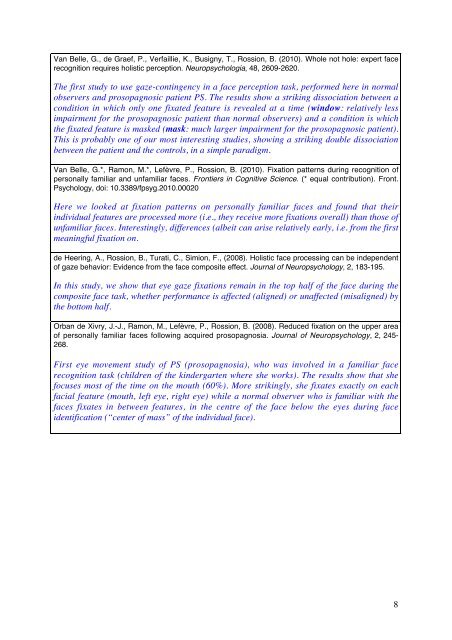Eye gaze fixations and gaze-contingency during face perception - UCL
Eye gaze fixations and gaze-contingency during face perception - UCL
Eye gaze fixations and gaze-contingency during face perception - UCL
You also want an ePaper? Increase the reach of your titles
YUMPU automatically turns print PDFs into web optimized ePapers that Google loves.
Van Belle, G., de Graef, P., Verfaillie, K., Busigny, T., Rossion, B. (2010). Whole not hole: expert <strong>face</strong><br />
recognition requires holistic <strong>perception</strong>. Neuropsychologia, 48, 2609-2620.<br />
The first study to use <strong>gaze</strong>-<strong>contingency</strong> in a <strong>face</strong> <strong>perception</strong> task, performed here in normal<br />
observers <strong>and</strong> prosopagnosic patient PS. The results show a striking dissociation between a<br />
condition in which only one fixated feature is revealed at a time (window: relatively less<br />
impairment for the prosopagnosic patient than normal observers) <strong>and</strong> a condition is which<br />
the fixated feature is masked (mask: much larger impairment for the prosopagnosic patient).<br />
This is probably one of our most interesting studies, showing a striking double dissociation<br />
between the patient <strong>and</strong> the controls, in a simple paradigm.<br />
Van Belle, G.*, Ramon, M.*, Lefèvre, P., Rossion, B. (2010). Fixation patterns <strong>during</strong> recognition of<br />
personally familiar <strong>and</strong> unfamiliar <strong>face</strong>s. Frontiers in Cognitive Science. (* equal contribution). Front.<br />
Psychology, doi: 10.3389/fpsyg.2010.00020<br />
Here we looked at fixation patterns on personally familiar <strong>face</strong>s <strong>and</strong> found that their<br />
individual features are processed more (i.e., they receive more <strong>fixations</strong> overall) than those of<br />
unfamiliar <strong>face</strong>s. Interestingly, differences (albeit can arise relatively early, i.e. from the first<br />
meaningful fixation on.<br />
de Heering, A., Rossion, B., Turati, C., Simion, F., (2008). Holistic <strong>face</strong> processing can be independent<br />
of <strong>gaze</strong> behavior: Evidence from the <strong>face</strong> composite effect. Journal of Neuropsychology, 2, 183-195.<br />
In this study, we show that eye <strong>gaze</strong> <strong>fixations</strong> remain in the top half of the <strong>face</strong> <strong>during</strong> the<br />
composite <strong>face</strong> task, whether performance is affected (aligned) or unaffected (misaligned) by<br />
the bottom half.<br />
Orban de Xivry, J.-J., Ramon, M., Lefèvre, P., Rossion, B. (2008). Reduced fixation on the upper area<br />
of personally familiar <strong>face</strong>s following acquired prosopagnosia. Journal of Neuropsychology, 2, 245-<br />
268.<br />
First eye movement study of PS (prosopagnosia), who was involved in a familiar <strong>face</strong><br />
recognition task (children of the kindergarten where she works). The results show that she<br />
focuses most of the time on the mouth (60%). More strikingly, she fixates exactly on each<br />
facial feature (mouth, left eye, right eye) while a normal observer who is familiar with the<br />
<strong>face</strong>s fixates in between features, in the centre of the <strong>face</strong> below the eyes <strong>during</strong> <strong>face</strong><br />
identification (“center of mass” of the individual <strong>face</strong>).<br />
8


